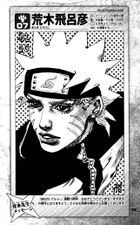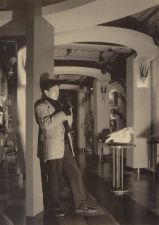Hirohiko Araki
Hirohiko Araki (荒木 飛呂彦, Araki Hirohiko) is a mangaka and author of JoJo's Bizarre Adventure, on which this wikia project is based.
Biography
Hirohiko Araki was born on June 7 1960 in Sendai, Japan. Araki left school before graduation from Miyagi University of Education.
Araki is best known for JoJo's Bizarre Adventure, published in Weekly Shonen Jump from 1987 to 2002, before the series transferred to the seinen magazine Ultra Jump in 2004.
Araki's Buso Poker was a "Selected Work" at the Tezuka Award in 1980.[1]
In 2012, Araki celebrates his 30th year as a manga artist and the 25th anniversary of JoJo’s Bizarre Adventure.
JoJo's Bizarre Adventure
The course of the story in JoJo takes the protagonists and the reader through numerous countries and the experience of many cultures. Through various means and at various degrees of factual accuracy and fictionalisation the history and cultures of Britain, the U.S., the Middle East, Japan and Italy in particular are explored and annotated. Many instances of names, styles, concepts or segments of stories originating or expressed in music, film, fashion, television and other comics and manga are readily identifiable in the story and expression of the manga (occasionally Araki makes specific mention of productions in interviews or in the blurbs of JoJo tankōbon). JoJo also spans a range of genres including or as a provisional description: Science Fiction, Paranormal & the Supernatural, Mystery & Thriller, and Action. Recurrent themes include Class; Ethics and Morality; Crime and Punishment; Health, Psychology and Memory; Fortune, Religion and Redemption; physical concepts such as Gravity, Time and Energy and their utilisation; and Family, Evolution and Lineage.
The character Rohan Kishibe may be considered a vehicle for the most autobiographical, opinionated or self-conscious elements of JoJo, while the fictional town of Morioh as visited in Part IV: Diamond is Unbreakable and the ongoing Part VIII: Jojolion may represent Araki's favorite aspects of his hometown of Sendai or Japanese culture, especially in a modern and/or contemporary sense.
Publication
Many of Araki's creations, including JoJo's Bizarre Adventure, have been translated and released in Europe, but so far only JoJo and Baoh have been released in the U.S.; one theory being that Araki's frequent references to Western music, film, and others violate either U.S. or other copyright laws. Publications by Viz Media avoid this problem by replacing certain references within the copy of the manga with thematically comparable alternatives.
Style and Influences
Hirohiko Araki has named Paul Gauguin as an influence.
In the early style of JoJo an analogy may be drawn with Tetsuo Hara's style (as most famously expressed in Fist of the North Star / Hokuto no Ken). Part IV exhibits a transition to a more androgynous style in the depiction of human characters, while Part VII seems overtly inspired by haute couture.
The layout and perspective of Part VII: Steel Ball Run seems distinctly cinematic, and should be compared to its namesake The Cannonball Run (dir. Hal Needman, 1981).
Araki consistently makes expressive use of the picture plane in his drawing and layout, most obviously in terms of anatomy and perspective.
Works
- Buso Poker (1980)
- Autoto Man (1982)
- Virginia ni Yohroshiku (1982)
- Magic Boy B.T. (魔少年ビーティー mashōnen bītī 1982–1983)
- Baoh (1984–1985)
- Gorgeous Irene (1985–1986)
- JoJo's Bizarre Adventure (1987—current)
- Part I: Phantom Blood (1987-1988)
- Part II: Battle Tendency (1988-1989)
- Part III: Stardust Crusaders (1989-1992)
- Part IV: Diamond is Unbreakable (1992-1996)
- Part V: Vento Aureo (1996-1999)
- Part VI: Stone Ocean (2000-2003)
- Part VII: Steel Ball Run (2004-2011)
- Part VIII: Jojolion (2011-current)
- JoJo 6251 (1993) (Artbook)
- Under Execution, Under Jailbreak (Collection) (1999)
- JOJO A-GO!GO! (2000) (Artbook)
- The Lives of Eccentrics (2004)
- Thus Spoke Rohan Kishibe - Mutsukabeza (2006)
- Front cover of Cell (scientific journal) (September 7, 2007)
- Rohan at the Louvre (2010)
- Spur Spinoff (2011)





